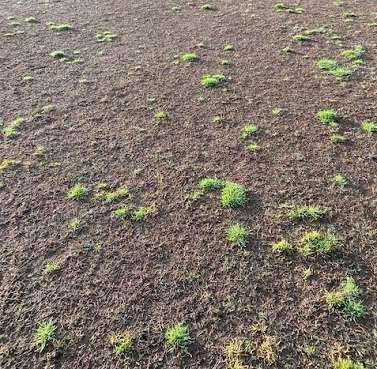7 Reasons for pre-emergent failure.
Here are 7 reasons for pre-emergent failure. We are often asked, why does my pre-emergent herbicide not work? Timing is the obvious reason but there could be several other causes. For example, incessant spring rain in 2022 in Sydney and QLD had a major impact on pre-emergent herbicide results. There are several factors that can affect herbicide results.
List of 7 reasons for pre-emergent failure.
Reasons for herbicide failure – 1
Timing – Is it too late to apply a pre-emergent herbicide for turf when I can see weeds?
In 99% of cases, apply pre-emergent herbicides before weed seeds germinate. Knowing how to use pre-emergents properly is important to get the best results. Use them after this and they won’t work. That’s why applying a pre-emergent and a post- emergent like a sulfonylurea herbicide at the same time is good practice.
Knowing what your target weeds are is key to successful treatment. Perennial weeds such as Buckhorn Plantain and Dandelion typically germinate in the late Autumn or early Spring. Winter annuals include Speedwells, Common Chickweed, Henbit and Bittercress.
Using pre-emergent herbicides at the wrong time can have a big impact on overseeding cool season grasses.
Reasons for herbicide failure – 2
Weed ID – How do I know what weed to control?
This is a major reason for herbicide failure because not all pre-emergent herbicides are effective against the same weeds. If you don’t know what you are targeting how can you expect to control the weed properly? The Gilba Solutions turf weed guide will help you identify your weeds correctly.
Reasons for herbicide failure – 3
Water – If it rains heavily after I apply my pre-emergent herbicide, will it still work?
Heavy rain shortly after you use a pre-emergent herbicides can move them out of the target zone. This is especially likely in high sand root zones. Pre-emergent herbicides work by staying in the top layer of the rootzone to suppress weed emergence. If you expect heavy rainfall in the season, turf managers should think about split applications if the label allows it.
The water solubility of a pre-emergent herbicide impacts its leaching potential after rainfall. Leaching occurs when the herbicide dissolves in water and moves down through the soil profile. A good example of this is metolachlor (Pennmag® or Meteor®), which is highly soluble in water. Under heavy rainfall, this moves more quickly from the coarse-textured (such as sandy) soils. In contrast, pendimethalin (ProForce Battalia 435) is relatively immobile in the soil.
Reasons for herbicide failure – 4
Resistance – I’ve been using the same pre-emergent herbicide for years but it doesn’t seem to work anymore.
So here we are over half-way through 7 reasons for pre-emergent failure. Repeatedly using the same chemical herbicide group can result in the development of herbicide resistance. In the Australian turf market, the majority of the pre-emergent herbicides used are in the dinitroaniline (DNA) family. This includes Battalia® (pendimethalin), Dimension® (dithiopyr) and ProForce Onset 10GR® (prodiamine).
Exceptions to this are Echelon Duo® (oxadiazon), Envu Specticle® (indaziflam) and Pennmag® (metalochlor). 2018 work in the US on pre-emergent herbicides for winter grass control, found that 58% of winter grass has some degree of herbicide resistance to prodiamine.
Reasons for herbicide failure – 5
Soil temperature – What is the best timing for my pre-emergent herbicide application?
Spring Pre-Emergents. Best apply when the soil temperature are at 12℃ for 2–3 days.
Autumn Pre-Emergents. Apply when soil temperatures are 21℃ for 2–3 days.
Reasons for herbicide failure – 6
Irrigation timing – Do I have to water in my pre-emergent herbicide immediately?
You do not need to immediately water in granular pre-emergent herbicides. However, most products give the best results with at least 6mm of water within 2–3 days. One problem with granular pre-emergents is that if you get a heavy downpour of rain these can wash off site. That is why once you use them, you should water them in as soon as possible.
You need to water in liquid pre-emergent herbicides to reach the soil. However, with some of these, there is some degree of leeway. For example. Specticle herbicide® has a 21-day window for watering in.
Reasons for herbicide failure – 7
Organic amendments – can humic acid affect my pre-emergent herbicide?
If you use some proucts with pre-emergent herbicides such as Barricade® or Specticle®, it can affect the results you get and be a reason for herbicide failure. Let me explain further.
Both soil type and organic matter influence pre-emergent behaviour. For example, work by Tielen in 2010, shows that higher organic matter content results in a lower herbicide efficacy for Frontier (dimethenamid-P) for three weed species (chickweed, groundsel and summergrass). This is likely due to organic matter content and its influence on soil sorption. Sorption is based on factors such as the amount and quality of soil organic carbon, texture, pH, and soil moisture
Many labels of pre-emergent products recommend the use of activated charcoal to neutralize pre-emergent herbicides. For example, with Specticle®, activated charcoal has been shown to deactivate this if applied within several days of application.
Some products available in Australia contain activated charcoal or are marketed as fertilizers coated with an organic material. This raises a question. Can these reduce the performance of pre-emergent herbicides? This includes products like prodiamine (Barricade®), indazaflam (Specticle®) and oxadiazon (Oxafert®).
One such product is Humic DG®. To quote ”contains highly oxidized carbon and organic acids that, in close association with certain classes of pre-emergent herbicides, may interfere with their efficacy. These results show that the application rate of herbicides should be adjusted to account for within-field variation in soil organic matter”.
Another example is Carbon Trader®, which is a water-dispersible granule of activated carbon and is often used to colour up turf areas.
FAQ
What is the Best pre emergent herbicide for lawns?
What is the best pre-emergent for your lawn depends on what grass you have present, what you are trying to control and how long you want it to last.
The most unique option to consider is Echelon Duo which not only prevents weeds for up to 12 weeks but also prevents scarab larvae and is a fertiliser.
For warm season turf I like Onset 10GR and Specticle as both of these have a long residual and have a wide spectrum of control. These both do a great job keeping weeds out of turf areas.
For cool season turf Onset 10GR and Barricade are good options.
All of the options above stop weed germination and prevent weeds such as Crowsfoot Grass, Summer Grass, Winter Grass, Paspalum and other grassy weeds. You can also mix these with postt emergent herbicides to give an even broader spectrum of control.
How to use pre emergent herbicides
Pre emergent herbicides form a barrier at the soil surface and prevent weeds from establishing. They have no effect at all on weed seeds.
1. The key to getting these to work is Timing.
-
The best time to apply these is before weeds germinate. As a general rule if you can see weeds your too late.
-
There are two times when you want to apply pre-emergent herbicidees. In the Autumn to target Winter weeds and in the Spring to target Summer weeds.
2. Application.
There are two options:
- Granular. You need to use a hand spreader and these products include Echelon Duo and Onset 10GR.
- Liquid. Barricade and Specticle are in this category.
- Immediately after you apply your pre-emergent, water thoroughly to wash the herbicide into the soil. Ideally, you shoud aim for at least 3mm of rain or irrigation.
Does pre emergent herbicide kill grass?
If you follow the label the answer is a simply no.
Where to buy pre emergent herbicide near me?
Gilba solutions supplies into NSW, VIC, QLD and the ACT. For areas outside of these feel free to contact us and we are only too happy to point you in the right direction as to where to get product at the best price.
Are there any new pre emergent herbicides?
The newest pre emergent active ingredient is indaziflam sold as Specticle® which was introduced several years ago. However, the newest products on the market are both granular products and produced by Indigo Specialty. These are called Echelon Duo® and Onset 10GR® These are based on oxadiazon and prodiamine respectively.
When to apply pre-emergent herbicide?
When to apply a pre emergent herbicide is going to depend on where you are.
- In Sydney to get the best results for your pre-emergent herbicide, apply these from the late Summer to the Early Autumn (February to April). If you use this timing it targets Winter weeds like Winter Grass. You can then look at re-applying in the Spring (August to September) to target Summer weeds like Summer grass and Crowsfoot and prevent these from germinating.
- If you are in Canberra or the Southern Highlands apply your pre-emergents before soil temperatures drop below 12C. This is generally around late February to early March to target Winter weeds. For Summer weeds you need to apply in the early September.

Jerry Spencer
Graduated from Newcastle University with an Hons Degree in Soil Science in 1988, Jerry then worked for the Sports Turf Research Institute (STRI) as a turf agronomist before emigrating to Australia in 1993.
He followed this by gaining a Grad Dip in Business Management from UTS. He has worked in a number of management roles for companies as diverse as Samsung Australia, Arthur Yates and Paton Fertilizers.
He has always had a strong affinity with the Australian sports turf industry and as a result he established Gilba Solutions as an independent sports turf consultancy in 1993. Jerry has written over 100 articles and two books on a wide range of topics such as Turf Pesticides and Nutrition which have been published in Australia and overseas.

